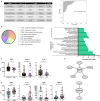A Differential Signature of Circulating miRNAs and Cytokines Between COVID-19 and Community-Acquired Pneumonia Uncovers Novel Physiopathological Mechanisms of COVID-19
- PMID: 35087533
- PMCID: PMC8787267
- DOI: 10.3389/fimmu.2021.815651
A Differential Signature of Circulating miRNAs and Cytokines Between COVID-19 and Community-Acquired Pneumonia Uncovers Novel Physiopathological Mechanisms of COVID-19
Abstract
Coronavirus Disease 2019 (COVID-19) pneumonia is a life-threatening infectious disease, especially for elderly patients with multiple comorbidities. Despite enormous efforts to understand its underlying etiopathogenic mechanisms, most of them remain elusive. In this study, we compared differential plasma miRNAs and cytokines profiles between COVID-19 and other community-acquired pneumonias (CAP). A first screening and subsequent validation assays in an independent cohort of patients revealed a signature of 15 dysregulated miRNAs between COVID-19 and CAP patients. Additionally, multivariate analysis displayed a combination of 4 miRNAs (miR-106b-5p, miR-221-3p, miR-25-3p and miR-30a-5p) that significantly discriminated between both pathologies. Search for targets of these miRNAs, combined with plasma protein measurements, identified a differential cytokine signature between COVID-19 and CAP that included EGFR, CXCL12 and IL-10. Significant differences were also detected in plasma levels of CXCL12, IL-17, TIMP-2 and IL-21R between mild and severe COVID-19 patients. These findings provide new insights into the etiopathological mechanisms underlying COVID-19.
Keywords: COVID-19; community-acquired pneumonia; microRNAs; plasma; soluble proteins.
Copyright © 2022 Martínez-Fleta, Vera-Tomé, Jiménez-Fernández, Requena, Roy-Vallejo, Sanz-García, Lozano-Prieto, López-Sanz, Vara, Lancho-Sánchez, Martín-Gayo, Muñoz-Calleja, Alfranca, González-Álvaro, Galván-Román, Aspa, de la Fuente and Sánchez-Madrid.
Conflict of interest statement
The authors declare that the research was conducted in the absence of any commercial or financial relationships that could be construed as a potential conflict of interest.
Figures


References
-
- Rodríguez-Serrano DA, Roy-Vallejo E, Zurita Cruz ND, Ramírez AM, Rodríguez-García SC, Arevalillo-Fernández N, et al. . Detection of SARS-CoV-2 RNA in Serum is Associated With Increased Mortality Risk in Hospitalized COVID-19 Patients. Sci Rep (2021) 11:13134. doi: 10.1038/s41598-021-92497-1 - DOI - PMC - PubMed
Publication types
MeSH terms
Substances
LinkOut - more resources
Full Text Sources
Medical
Research Materials
Miscellaneous

